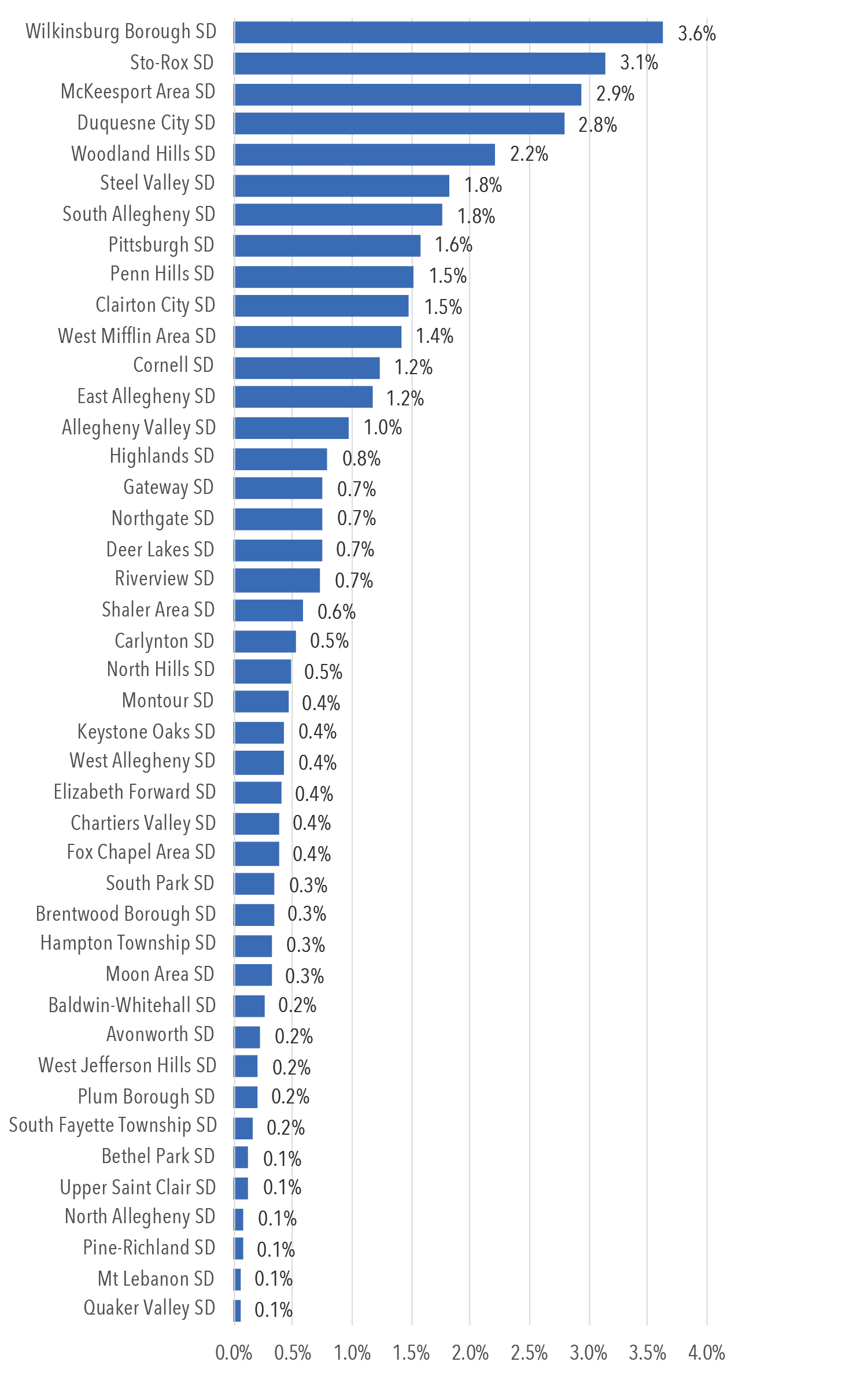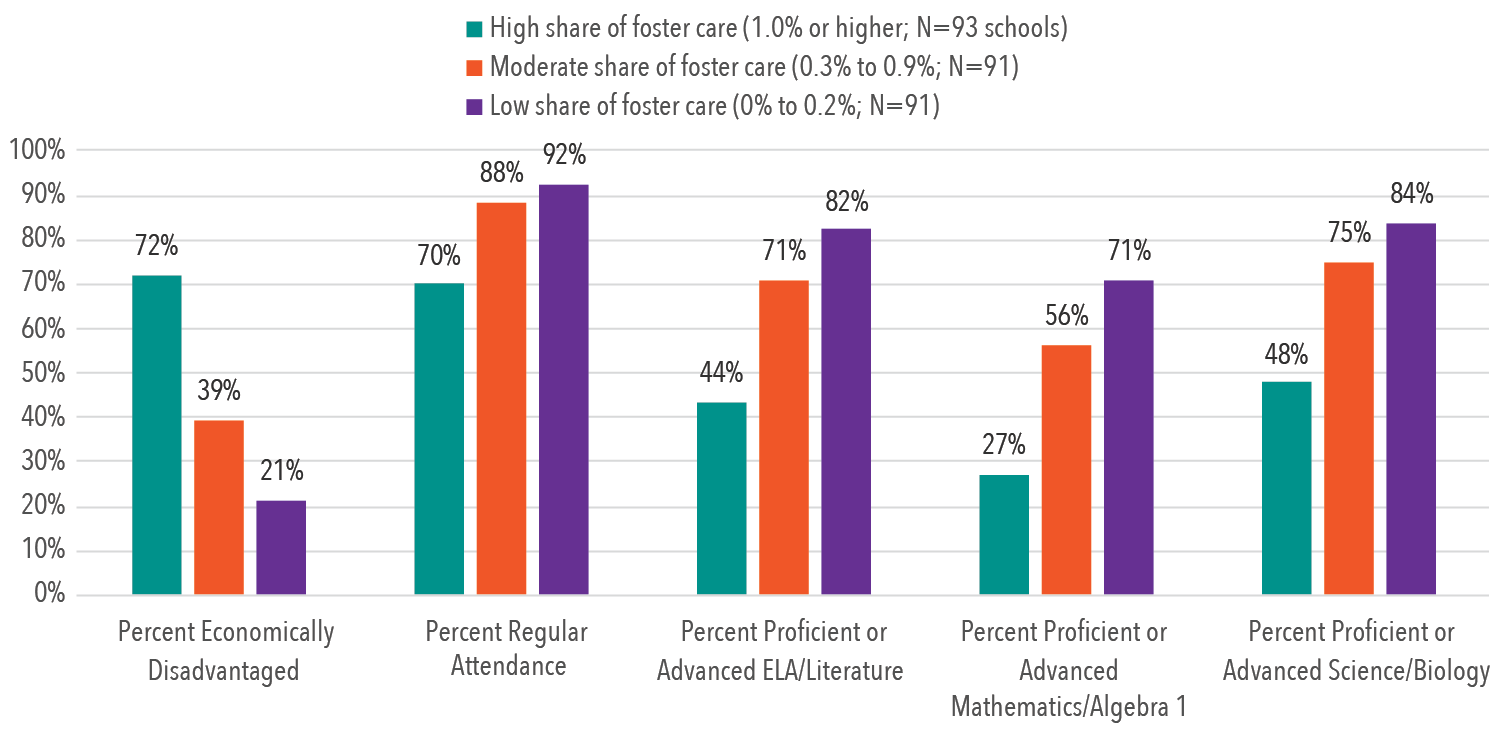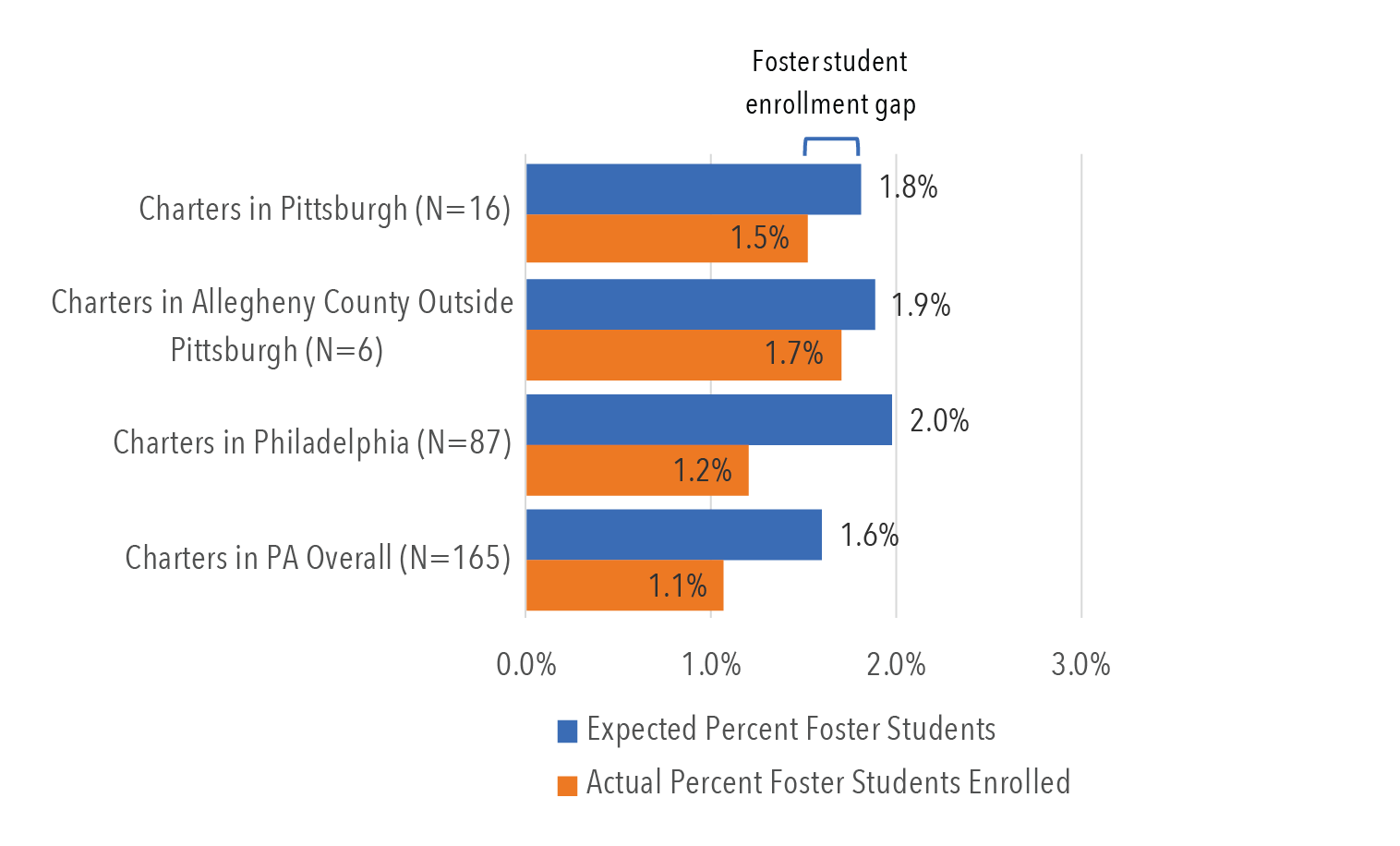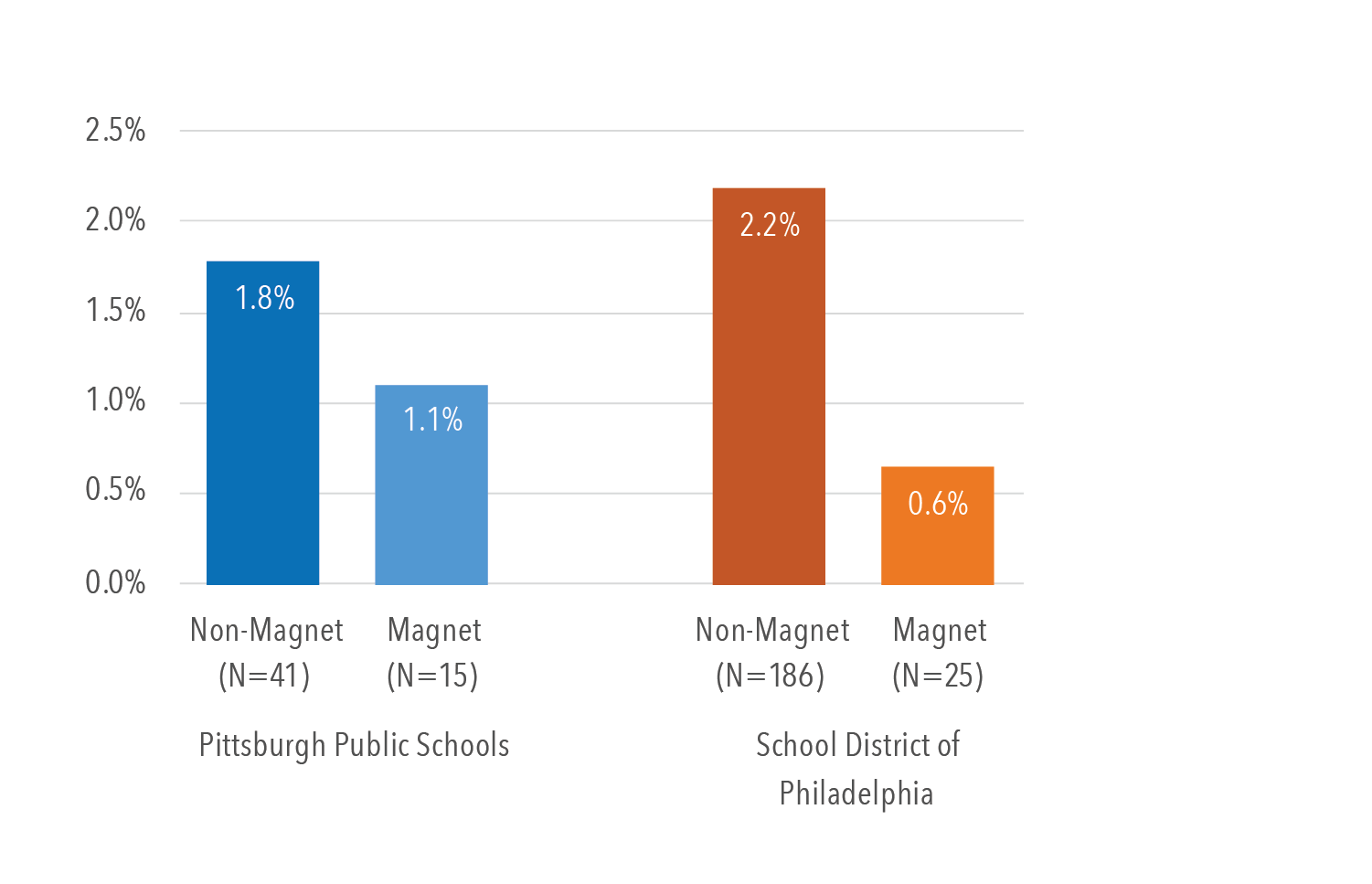
Students in Foster Care in Allegheny County: Analysis of New Enrollment Data
A publication of the Allegheny County Education Research (ACER) project
Authors: Anna Shaw-Amoah, Dae Y. Kim and David Lapp
I. Educational Needs of Students in Foster Care
Students in foster care experience among the highest dropout rates of any student group, are more likely to attend low-performing schools, and are more likely to have a diagnosed disability.1 Of particular relevance during an era of online instruction due to the COVID-19 pandemic, students in foster care may be more likely to lack an online connection via laptop or mobile device and often rely on public spaces for internet access, which places them at even more risk for falling behind academically.2 The Federal Fostering Connections Act and Every Student Succeeds Act requires all Local Education Agencies (LEAs) to promote stability for students in foster care and support them to succeed academically through these challenges,3 regardless of the type of school these students attend. Advocates for youth in foster care further recommend frequent check-ins with school points of contact and point to the urgent need to help these students access critical services so that they can continue instruction virtually and maintain healthy connections with peers and teachers.4
Yet, until recently data on where students in foster care are enrolled in Pennsylvania schools has not been publicly available. This year, the Pennsylvania Department of Education’s Future Ready PA Index website included new school-level data on the enrollment of students in foster care in every Pennsylvania public school.5
As part of Research for Action’s Allegheny County Education Research (ACER) series, this brief examines these new data on foster care for students enrolled in Allegheny County schools. We first discuss where students in foster care are most concentrated and the characteristics of those schools. We also compare enrollment differences between charter and district schools, and examine magnet schools within Pittsburgh Public Schools as well. Where applicable for comparative purposes, data is also included from Philadelphia, Pennsylvania’s other large city with substantial charter and magnet school sectors, as is data on Pennsylvania schools overall.
II. Allegheny County Students in Foster Care
Enrollment of Students in Foster Care in Allegheny County School Districts
Overall, more than 1,200 students in Allegheny County public schools, including both district and charter schools, are students in foster care. This amounts to 0.8% of all students, a marginally higher rate than in Pennsylvania overall (0.7%; 11,845 students). However, this rate varies by school districts in the county. Figure 1 provides the enrollment of students in foster care for all 44 school districts in Allegheny County.
Figure 1: Percentage of Students in Foster Care by Allegheny County School District

As shown in the chart:
- Four districts serve roughly three times the county-wide rate of students in foster care, including Wilkensburg Borough (3.6%; 19 students in foster care), Sto-Rox (3.1%; 39 students), McKeesport Area (2.9%; 95 students), and Duquesne City (2.8%; 10 students) School Districts.
- Pittsburgh (1.6%) ranks 8th among Allegheny County school districts for the highest percentage of students in foster care. By far the largest school district in Allegheny County, PPS also serves the largest number of students in foster care by district at 360.
- In contrast, six school districts serve less than 0.1% students in foster care: Upper Saint Clair, Bethel Park, North Allegheny, Pine-Richland, Quaker Valley, and Mt. Lebanon School Districts (fewer than ten students in foster care each).
School-Level Enrollment of Students in Foster Care in Allegheny County
RFA created the following interactive map in Figure 2 below to more closely examine the distribution of students in foster care at the school level. The map can be filtered by district, grade level, and type of school in Allegheny County.
Figure 2: Where Are Allegheny County’s Students in Foster Care Enrolled in School?
This analysis reveals the following notable findings:
- Enrollment of students in foster care varies considerably by school. Out of 275 total public schools in Allegheny County with available data, 58 schools serve zero students in foster care. At the other end of the continuum, more than 10% of the enrollment at two schools are students in foster care (Pittsburgh Oliver High School and Hill House Passport Academy Charter School).
- Even within districts, there is significant variation by school. For example, in Pittsburgh Public Schools (PPS, N=55), three schools enroll zero students in foster care (Pittsburgh Montessori K-5, Pittsburgh Pioneer, and Pittsburgh Online Academy) while over 14% of one school’s students are in foster care (Pittsburgh Oliver High School).
- Among charter schools (N=23), there is also substantial variation in enrollment of students in foster care. Proportion of enrolled students who are in foster care range from over 11% (Hill House Passport Academy Charter School) to 0% in two charter schools (Young Scholars of Western Pennsylvania Charter School and Spectrum Charter School).
Characteristics of Allegheny County Schools with Varying Enrollment of Students in Foster Care
Figure 3 below provides more detail on the characteristics of Allegheny County schools with high, moderate, and low enrollment of students in foster care.
Figure 3: Characteristics of Allegheny County Schools by Enrollment of Students in Foster Care

Students in foster care require high functioning and well-resourced schools. However, Allegheny County schools with high concentrations of students in foster care have more economically disadvantaged students, worse attendance rates, and lower academic proficiency in English, math, and science compared to schools with moderate or low enrollment of students in foster care.
III. Do Allegheny County Charter Schools Equitably Serve Students in Foster Care?
In the 2018-19 school year, charter schools enrolled 6% of all public school students in Allegheny County – twice the rate from 10 years prior when charter schools made up less than 3% of student enrollment in the county.6 Studies have found that charter schools in Pennsylvania often do not equitably enroll students with additional learning needs, such as students experiencing homelessness,7 English language learners, and students with severe disabilities.8 Below we present our analysis of the enrollment of students in foster care in Allegheny County charter schools. We first explain how we created an indicator for determining whether charter schools serve an equitable share of students in foster care.
Calculating the Expected Level of Foster Student Enrollment in Charter Schools
Many students attending charter schools reside in the school district in which the charter school is physically located (i.e. most students in Pittsburgh charter schools are residents of Pittsburgh and would otherwise attend PPS). However in some communities, charter school enrollment is comprised of students from many different school districts. To understand whether Allegheny County charter schools are serving an equitable share of students in foster care, we calculated an expected percentage of foster students in each charter school. The expected percentage is based on the percentage of students in foster care in each sending school district (the districts in which charter students reside) and weighted by the portion of the overall enrollment of students from each district.[i]
Tables 1 and 2 below provide the data used to calculate the expected percentages of students in foster care for brick-and-mortar charter schools located in Pittsburgh and in the rest of Allegheny County.9
Table 1: Calculating Expected Enrollment of Students in Foster Care for Pittsburgh Charter Schools
| Sending District Name | Student Enrollment in Pittsburgh Charter Schools by Sending District | Percent Students in Foster Care in Sending District | Expected Percent Foster Students in Pittsburgh Charter Schools |
| Pittsburgh SD | 53% | 1.6% | = 1.8% foster care weighted average
|
| Woodland Hills SD | 12% | 2.2% | |
| Penn Hills SD | 9% | 1.5% | |
| Sto-Rox SD | 8% | 3.1% | |
| Wilkinsburg Borough SD | 4% | 3.6% | |
| McKeesport Area SD | 3% | 2.9% | |
| 47 Other Districts | 11% | 0.6% |
Table 2: Calculating Expected Enrollment of Students in Foster Care for Charter Schools in Allegheny County Outside Pittsburgh
| Sending District Name | Students Attending Charter Schools from Each Sending District | Percent Students in Foster Care in Sending District | Expected Percent Foster Students in Charter Schools in Allegheny County Outside Pittsburgh |
| Woodland Hills SD | 18% | 2.2% | = 1.9% foster care weighted average
|
| Pittsburgh SD | 18% | 1.6% | |
| McKeesport Area SD | 16% | 2.9% | |
| Steel Valley SD | 9% | 1.8% | |
| Penn Hills SD | 8% | 1.5% | |
| Duquesne City SD | 6% | 2.8% | |
| 36 Other Districts | 26% | 0.6% |
Equitable Foster Student Enrollment in Allegheny County’s Charter Sector
Figure 4 below shows that the brick-and-mortar charter sectors in Pittsburgh and in Allegheny County outside of Pittsburgh serve foster students at only slightly lower than expected rates, based on the districts in which their students reside. Charter schools located in Pittsburgh enrolled 1.5% students in foster care compared to 1.8% expected foster enrollment (95 students in foster care enrolled to 114 expected). Charter schools in Allegheny County outside of Pittsburgh enrolled 1.7% students in foster care compared to 1.9% expected foster enrollment (32 students in foster care enrolled to 35 expected).
Figure 4 further places these data in context with Pennsylvania’s largest city and county, as well as with the state overall. Philadelphia’s charter sector and charters in Pennsylvania overall serve lower rates of students in foster care than would be expected. Charter schools in Philadelphia enrolled 1.2% students in foster care compared to 2.0% expected foster enrollment (795 students in foster care enrolled compared to 1,308 expected). Pennsylvania charter schools overall enrolled 1.1% students in foster care compared to 1.6% expected enrollment (1,135 students in foster care enrolled to 1,698 expected).
Figure 4: PA Charter Schools: Actual Percent Foster Care Enrollment vs. Expected Foster Care Enrollment

Note: Cyber charter schools are excluded from this analysis.
IV. Do Pittsburgh’s Magnet Schools Equitably Serve Students in Foster Care?
Magnet schools are defined by special enrollment processes and rigorous course offerings. In PPS, magnet school applicants must submit application materials, meet academic benchmarks, and/or maintain a high attendance rate in the prior year to be considered for admission.10 This is similar to admissions criteria in other districts, including magnet schools in the School District of Philadelphia (SDP).11
Within PPS, we compared the enrollment of students in foster care between magnet and non-magnet district schools. Shown in Figure 5, magnet schools in PPS serve a lower rate of students in foster care (1.1%; 87 students in foster care) compared to non-magnet schools in PPS (1.8%; 260 students in foster care). However, the disparities in PPS are smaller than in Philadelphia, the other Pennsylvania school district with a large magnet sector. In Philadelphia magnet schools serve only 0.6% (103 students in foster care) compared to 2.2% (2,365 students in foster care) in non-magnet schools.
Figure 5: Percent Foster Care; Magnet vs. Non-Magnet Schools

Note: Allegheny County outside of PPS not shown because there is just one magnet school.
V. Next Steps for Allegheny County School Leaders
The COVID-19 pandemic has placed issues of educational equity and gaps in student resources in sharp relief. During this time of additional instability, it is critical that school and district leaders understand the enrollment patterns of students in foster care in order to address the additional supports that students need to succeed and thrive in public schools.
This snapshot of foster student enrollment in Pittsburgh and Allegheny County public schools reveals where foster students are enrolled, and which schools may not be equitably serving this vulnerable group. The findings from this analysis of newly-available data show that students in foster care are not evenly distributed across school districts in Allegheny County. Even within districts, enrollment varies considerably, concentrating this vulnerable group in schools with lower attendance rates, more economically disadvantaged students, and worse academic achievement. Charter schools in Allegheny County are found to under-enroll students in foster care compared to the districts where students reside, although these schools serve a more equal portion of students in foster care when compared to charter schools in Philadelphia and the state overall. Finally, Pittsburgh’s academically selective magnet schools also enroll a lower share of students in foster care than non-magnet district schools.
LEAs must support students in foster care to achieve academically, including promoting educational stability in these students’ lives and collaborating with state and child welfare agencies.12 However, the findings of this analysis show that some schools within Allegheny County are not equitably enrolling these vulnerable students. Policymakers should consider these data when prioritizing resources and additional supports, as these services bring added expenses to schools and school districts.13 Additionally, as school buildings reopen and students return to in-person instruction, policymakers should examine practices that may keep students in foster care from equitably accessing all kinds of schools, including charter schools, magnet schools, and schools with higher student outcomes.
[i] The following formulas show how we calculated the expected level of foster student enrollment in charter schools:
